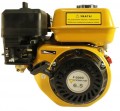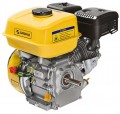Power
The rated power of the engine (the highest power it can deliver in normal operation) in kilowatts. Initially, the power of internal combustion engines (ICE) was usually denoted in horsepower, but now it is also common to record in watts / kilowatts; this, in particular, makes it easier to compare the power of internal combustion engines and electric motors. Some units can be converted to others: 1 hp approximately equal to 0.735 kW.
In general, the more powerful the engine, the more speed and tractive effort it is able to develop. On the other hand, this indicator directly affects the weight, dimensions, and most importantly, the cost of the unit, while the real need for high power is relatively rare. Therefore, it is worth choosing according to this indicator, taking into account the features of the planned application; specific recommendations on choosing an engine for a specific technique and tasks can be found in special sources. We only note that models of the same power can differ in speed and "torque"; see "Shaft speed" for details.
Max. torque
The maximum torque developed by the engine during operation. Note that such an indicator is usually achieved only at certain speeds — this nuance can be specified in the characteristics.
Torque can be simplistically described as the force exerted by a motor on a shaft. The higher this effort, the more “high-torque” the motor is, the better it overcomes resistance and handles with high loads. The torque value is directly related to the power. For example, for 5 hp models. and less torque
up to 10 Nm is considered quite normal, engines of 4 – 7 hp. give out
from 10 to 20 Nm, and values
of 20 Nm or more are found in units with a power of at least 8 hp. At the same time, engines of the same power may differ in actual force. So this indicator characterizes the capabilities of the unit well in comparison with analogues.
It is worth saying that many consider torque to be a more reliable and visual parameter than power: the latter can be indicated in different ways (nominal, maximum, etc.), while torque is a completely unambiguous characteristic.
Shaft rotation
Direction of rotation of the motor shaft. Usually, it is indicated by the direction in which the shaft rotates, if you look at it from the flywheel side (from the side of the engine from which the power is taken off). The classic option is counterclockwise rotation, but the opposite direction is also found. Anyway, the main selection criterion for this parameter is what direction the car is designed for, under which the engine is bought.
Shaft speed
The highest shaft speed provided by the motor. Before buying, you should make sure that this indicator corresponds to the characteristics of the equipment in which you plan to install the engine — too high a speed can damage the working tool, transmission units, etc.
It is also worth considering that a higher rotational speed (for the same engine power and transmission characteristics) means less torque, and vice versa. Therefore, this parameter allows you to compare engines in terms of the speed / thrust ratio (however, only on the condition that they do not have reduction gears — see "Functions").
Specific fuel consumption
Specific consumption in this case can be described as the amount of fuel consumed by the engine per hour per 1 kW of generated power. The lower this figure, the higher the efficiency of the engine and the more economical it is. Specific consumption data is especially useful for comparing units with different capacities.

